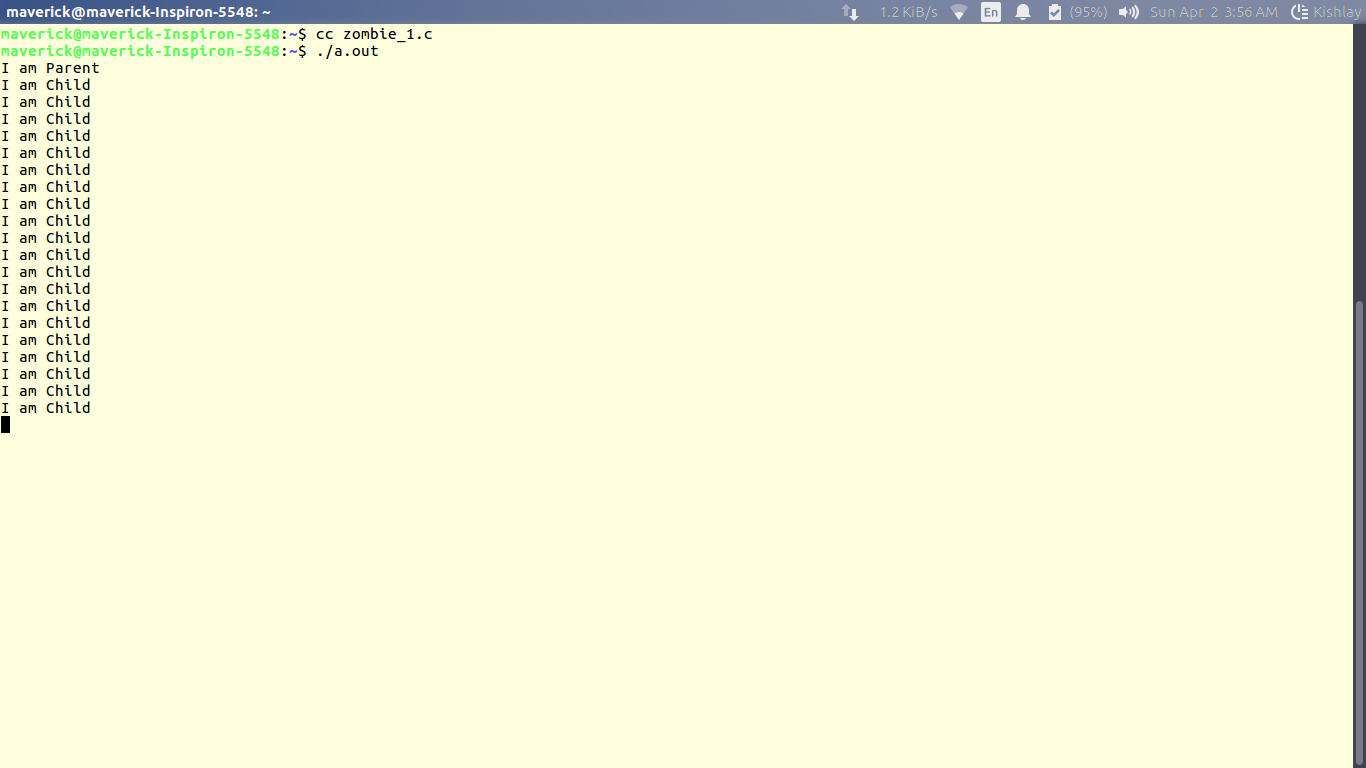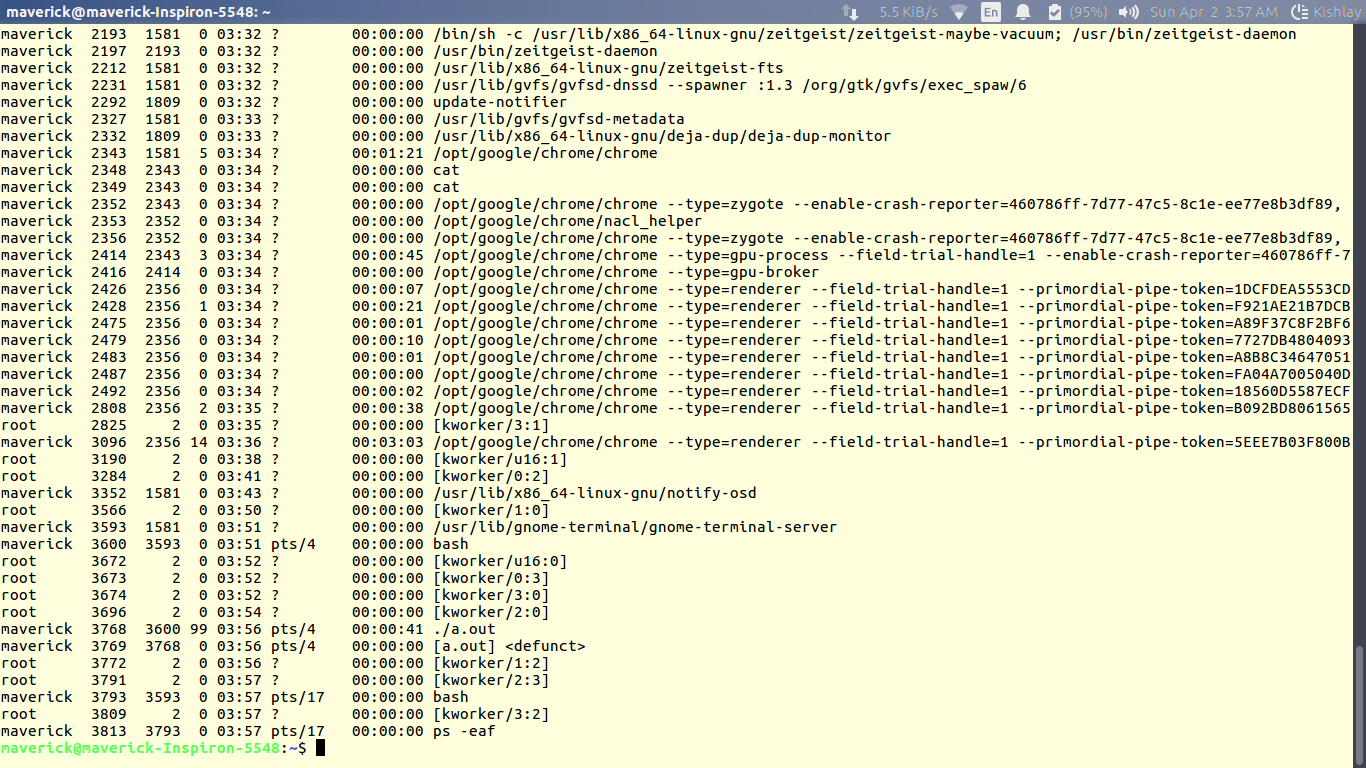Sigchld Parent Process Can Wait for the Completion
Prerequisites: fork() in C, Zombie Process
Zombie state: When a process is created in UNIX using fork() system call, the address space of the Parent process is replicated. If the parent process calls wait() system call, then the execution of the parent is suspended until the child is terminated. At the termination of the child, a 'SIGCHLD' signal is generated which is delivered to the parent by the kernel. Parent, on receipt of 'SIGCHLD' reads the status of the child from the process table. Even though the child is terminated, there is an entry in the process table corresponding to the child where the status is stored. When the parent collects the status, this entry is deleted. Thus, all the traces of the child process are removed from the system. If the parent decides not to wait for the child's termination and executes its subsequent task, then at the termination of the child, the exit status is not read. Hence, there remains an entry in the process table even after the termination of the child. This state of the child process is known as the Zombie state.
C
#include<stdio.h>
#include<unistd.h>
#include<sys/wait.h>
#include<sys/types.h>
int main()
{
int i;
int pid = fork();
if (pid == 0)
{
for (i=0; i<20; i++)
printf ( "I am Child\n" );
}
else
{
printf ( "I am Parent\n" );
while (1);
}
}
Output :

Now check the process table using the following command in the terminal
$ ps -eaf

Here the entry [a.out] defunct shows the zombie process.
Why do we need to prevent the creation of the Zombie process?
There is one process table per system. The size of the process table is finite. If too many zombie processes are generated, then the process table will be full. That is, the system will not be able to generate any new process, then the system will come to a standstill. Hence, we need to prevent the creation of zombie processes.
Different ways in which the creation of Zombie can be Prevented
1. Using wait() system call: When the parent process calls wait(), after the creation of a child, it indicates that, it will wait for the child to complete and it will reap the exit status of the child. The parent process is suspended(waits in a waiting queue) until the child is terminated. It must be understood that during this period, the parent process does nothing just wait.
C
#include<stdio.h>
#include<unistd.h>
#include<sys/wait.h>
#include<sys/types.h>
int main()
{
int i;
int pid = fork();
if (pid==0)
{
for (i=0; i<20; i++)
printf ( "I am Child\n" );
}
else
{
wait(NULL);
printf ( "I am Parent\n" );
while (1);
}
}
2. By ignoring the SIGCHLD signal: When a child is terminated, a corresponding SIGCHLD signal is delivered to the parent, if we call the 'signal(SIGCHLD,SIG_IGN)', then the SIGCHLD signal is ignored by the system, and the child process entry is deleted from the process table. Thus, no zombie is created. However, in this case, the parent cannot know about the exit status of the child.
C
#include<stdio.h>
#include<unistd.h>
#include<sys/wait.h>
#include<sys/types.h>
int main()
{
int i;
int pid = fork();
if (pid == 0)
for (i=0; i<20; i++)
printf ( "I am Child\n" );
else
{
signal (SIGCHLD,SIG_IGN);
printf ( "I am Parent\n" );
while (1);
}
}
3. By using a signal handler: The parent process installs a signal handler for the SIGCHLD signal. The signal handler calls wait() system call within it. In this scenario, when the child terminated, the SIGCHLD is delivered to the parent. On receipt of SIGCHLD, the corresponding handler is activated, which in turn calls the wait() system call. Hence, the parent collects the exit status almost immediately and the child entry in the process table is cleared. Thus no zombie is created.
C
#include<stdio.h>
#include<unistd.h>
#include<sys/wait.h>
#include<sys/types.h>
void func( int signum)
{
wait(NULL);
}
int main()
{
int i;
int pid = fork();
if (pid == 0)
for (i=0; i<20; i++)
printf ( "I am Child\n" );
else
{
signal (SIGCHLD, func);
printf ( "I am Parent\n" );
while (1);
}
}
Output:

Here no any [a.out] defunct i.e. no Zombie process is created.
This article is contributed by Kishlay Verma. If you like GeeksforGeeks and would like to contribute, you can also write an article using write.geeksforgeeks.org or mail your article to review-team@geeksforgeeks.org. See your article appearing on the GeeksforGeeks main page and help other Geeks.
Please write comments if you find anything incorrect, or you want to share more information about the topic discussed above.
Sigchld Parent Process Can Wait for the Completion
Source: https://www.geeksforgeeks.org/zombie-processes-prevention/
0 Response to "Sigchld Parent Process Can Wait for the Completion"
Post a Comment